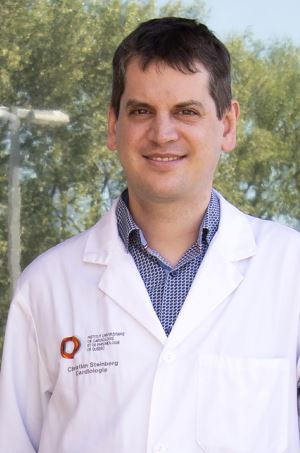Discoveries and Innovations
Discover
Sleep Disorders and Obesity
Dr. Natalie Jane Michael – Researcher in stress, sleep and mental health
 Sleep disturbances are common in today’s society. So a large portion of the population is not getting the recommended daily amount of sleep and many suffer from having a poor quality. Over the same period where sleep disorders have increased, obesity prevalence has a coinciding rise. There is also strong evidence of a close causal relationship between sleep alterations and the metabolic disorders involved in obesity pathophysiology. It is therefore important to better understand how sleep and metabolic processes are reciprocally controlled in order to elucidate the chronic health problems in our society associated with their disruption.
Sleep disturbances are common in today’s society. So a large portion of the population is not getting the recommended daily amount of sleep and many suffer from having a poor quality. Over the same period where sleep disorders have increased, obesity prevalence has a coinciding rise. There is also strong evidence of a close causal relationship between sleep alterations and the metabolic disorders involved in obesity pathophysiology. It is therefore important to better understand how sleep and metabolic processes are reciprocally controlled in order to elucidate the chronic health problems in our society associated with their disruption.
The brain plays a key role in the regulation of sleep and metabolic processes. A region of the brain called the hypothalamus has notably a role of particular importance. The function of this position in the brain is affected by sleep deprivation, but also by a high-fat diet intake. The hypothalamus represents in addition an important site of convergence for circuits involved in sleep regulation as well as metabolic signals and would thus contribute to the two-way relationship between sleep disorders and metabolic diseases.
Dr. Natalie J. Michael is a newly recruited researcher at the Institute whose work focuses on identifying the neural circuits that control sleep and metabolism. She is the current holder of the Sentinel North Partnership Research Chair on Sleep Pharmacometabolism. Her work revolves around a unique population of neurons in the hypothalamus that would explain the intimate relationship between sleep disorders and obesity. Supported by a career development grant from the Sleep Research Society Foundation (SRSF), the purpose of her research program is therefore to characterize the neurometabolic circuitry that allows these neurons to integrate the metabolic information and control energy metabolism and sleep.
We discovered special brain cells that are active when we are awake and silent when we are asleep are having a strong impact on eating under specific metabolic conditions. We are now trying to understand exactly how these cells respond to the body’s metabolic signals and how they influence eating behaviours. In doing so, we are using a combination of applied approaches to neuroscience, physiology, pharmacology as well as genetic techniques. This includes a specialized methodology that allows us to record the electrical activity of individual brain cells. These methods help us investigate the functioning of these brain regions essential for controlling sleep and metabolic processes.
We were incredibly fortunate to receive generous funding from the IUCPQ Foundation, the Cardiometabolic Health, Diabetes and Obesity Research Network (CMDO) and other national and local funders. This support enables us to further develop our capabilities and to position our laboratory at the junction of sleep and metabolism research. Our work will help generate crucial information for the prevention and treatment of metabolic dysfunctions related to less sleep, and even explain why certain medications that are commonly used can influence body weight. We therefore hope that the results of our efforts will eventually translate into improved patient health.
Prevent
Implantable Cardiac Defibrillators and Driving a Car
Dr. Christian Steinberg – Researcher in cardiology, translational research in hereditary arrhythmia and genetic cardiomyopathy
 Implantable cardioverter-defibrillators (ICDs) are effective cardiac devices for preventing sudden death caused by dangerous ventricular arrhythmias. Thousands of Canadians benefit every year from the insertion of an ICD. Many lives were saved in Canada and elsewhere in the world over the past 30 years through defibrillators. Approximately 500 new ICDs are implanted at the Institute each year.
Implantable cardioverter-defibrillators (ICDs) are effective cardiac devices for preventing sudden death caused by dangerous ventricular arrhythmias. Thousands of Canadians benefit every year from the insertion of an ICD. Many lives were saved in Canada and elsewhere in the world over the past 30 years through defibrillators. Approximately 500 new ICDs are implanted at the Institute each year.
There are globally two broad classifications of indications for ICD implantation: primary and secondary prevention. Primary prevention describes individuals without a history of ventricular arrhythmia, but who are deemed to be at high risk for future cardiac arrest. These are typically people with heart failure and strongly reduced cardiac contractile strength or other heart diseases at greater risk of dangerous arrhythmia. Secondary prevention includes all patients—regardless of their heart strength—who survived a cardiac arrest caused by an arrhythmia being harmful.
The ICD implantation is also associated with certain inconveniences despite undeniable benefits. One of these drawbacks has to do with the restrictions versus driving a car following the intervention. Current legislation in Quebec and all other Canadian provinces provides for a one-month period without an entitlement to drive an automobile after the ICD implantation in primary prevention, and half a year in case of secondary prevention. The same limitations are also applied in a lot of other industrialized countries. The idea behind these restrictions was to protect the public and the ICD wearer if he or she loses consciousness sitting at the wheel because of a recurrent arrhythmia that is dangerous. These limits have important impacts on these people’s social and professional quality of life, especially in remote areas with little public transit network.
It is important to know that the scientific data leading to the legislation in force are older than 20–30 years.
Given the lack of contemporary data, Dr. Christian Steinberg and his team recently done two major multicentre studies in Canada (DREAM-ICD-I and DREAM-ICD-II) to gauge the rate of ventricular arrhythmia and the risk of therapies delivered during the first year in individuals referred for ICD implantation. The DREAM-ICD-I study looked at male and female patients who underwent ICD insertion for primary prevention. The cardiac event rate in this cohort was very low. The rate of appropriate therapies delivered at 1, 3, and 6 months after ICD insertion was 0.12%, 0.50% and 0.75%, respectively. No person had experienced a loss of consciousness due to a dangerous arrhythmia within the first six months after the intervention in the DREAM-ICD-I study. Based on the DREAM-ICD-I data, a one-week restriction on driving a car (as it does for a normal cardiac pacemaker) would be safe and reasonable.
The DREAM-ICD-II study examined the patient population with ICD insertion for secondary prevention. The results of DREAM-ICD-II also showed much lower rates of ventricular arrhythmias compared with historical cohorts from 15–20 years ago. Researchers observed as well in the DREAM-ICD-II study that the risk of recurrent arrhythmia was highest during the first three months after initial cardiac arrest. The risk for ventricular arrhythmia as well as that of ICD therapy thereafter decreased significantly and remained fairly stable. Whereas old research still reported a risk of arrhythmia-related loss of consciousness while driving of 30%, only 5% of patients in the DREAM-ICD-II study became unconscious throughout it and no individual had syncope for a short period of time sitting at the wheel. The possibility of losing consciousness was the greatest within the first three months following the initial heart cessation. The results of DREAM-ICD-II suggest that a reduction in the period without driving a car from six to three months would be sufficient and safe.
Data from DREAM-ICD-I and DREAM-ICD-II demonstrate a sharp decline in arrhythmic events and ICD therapy in contemporary patients undergoing ICD insertion for primary or secondary prevention. This decrease is mainly explained by great progress in heart failure therapy and arrhythmia treatments as well as an enhanced ICD programming within the last 20 years. Researchers in the DREAM-ICD-I and DREAM-ICD-II propose in line with their outcomes looser restrictions regarding driving after ICD insertion. A revision of current recommendations could significantly improve the patients’ lives in Canada and in other parts of the world
Cure
Treatment of Pulmonary Arterial Hypertension
Drs. Steeve Provencher and Sébastien Bonnet – Principal investigators of the APPROACH study
 François Potus, researcher; Pascale Blais-Lecours, coordinator; Sarah Bernard, coordinator; Sandra Martineau, research professional; Sandra Breuils-Bonnet, research professional; Olivier Boucherat, researcher—Co-authors of the paper published in the American Journal of Respiratory and Critical Care Medicine.
François Potus, researcher; Pascale Blais-Lecours, coordinator; Sarah Bernard, coordinator; Sandra Martineau, research professional; Sandra Breuils-Bonnet, research professional; Olivier Boucherat, researcher—Co-authors of the paper published in the American Journal of Respiratory and Critical Care Medicine.
The direct alignment of the research components with the Institute’s missions on the clinical side supports translational research projects to be done, from the mechanistic to the discovery and validation of new therapeutic targets. The evaluation of a BRD4 inhibitor to treat pulmonary arterial hypertension (PAH) is one good example.
PAH is characterized by an excessive remodeling of pulmonary arterioles, leading to a progressive increase in resistance to blood flow. PAH ultimately results in the development of right-sided heart failure and early death despite current vasodilator therapies.
Although multiple and complex mechanisms are leading to pulmonary arterial remodeling, the work of the Pulmonary Hypertension Research Group (www.phrg.ca) helped demonstrate that this phenomenon is linked in particular to the pro-proliferative and anti-apoptotic phenotype of pulmonary artery smooth muscle cells. They had evidence in 2015 for the first time of the predominant role that BRD4, an epigenetic reader widely overexpressed in PAH, played in the development and progression of pulmonary vascular remodeling. Their work indeed showed that BRD4 favoured the transcription of very numerous genes involved in the disease going forward. So inhibition of BRD4 helps restore a normal pro-proliferative/anti-apoptotic phenotype of cells from pulmonary arteries and thus reverse vascular remodeling and pulmonary hypertension in various animal models. BRD4 was also overexpressed in the coronary vasculature of PAH patients, contributing to their remodeling and the start of a concomitant coronary artery disease. The therapeutic effect of BRD4 inhibition was subsequently evaluated in the first ever made randomized, multicenter preclinical PAH study. This work, done by three independent research teams using multiple animal models of PAH, confirmed that inhibiting BRD4 was not only effective in reversing vascular remodeling and improving pulmonary hemodynamics, but was specifically beneficial to the right ventricle (i.e. independently of its effect on the pulmonary circulation). The preclinical data therefore appeared sufficiently compelling to justify the evaluation of this new therapeutic target in patients that have PAH.
The pilot project APPROACH took place in two centres in Canada that are specializing in treating PAH. It was an open-label pilot clinical study, which assessed first the effect of epigenetic modulation (modulating gene transcription without modification of the genetic code) in PAH. This work helped demonstrate that the use of apabetalone, a BRD4 inhibitor, substantially improved pulmonary hemodynamics without having a significant side effect in PAH patients already undergoing maximum vasodilator therapy.
While hemodynamic improvement is an objective measure, these results obviously must be interpreted with caution, taking into account the study specifications and parameters. They nevertheless generated enough enthusiasm in the scientific community to be published in the prestigious American Journal of Respiratory and Critical Care Medicine and allow a major grant from the Canadian Institutes of Health Research (CIHR) to be obtained to do a randomized, double-blind, phase 2 clinical trial that will help confirm the efficacy and tolerability of the medication for treating PAH.
This long journey clearly reflects the hard work of many graduate students and professionals from the Institute’s Pulmonary Hypertension Research Team. It also demonstrates that the Institute’s Research Centre is an appropriate place where highly translational work can be done, the ultimate objective of which is to improve the survival and well-being of people with PAH.
*From the 2021-2022 Annual Report
